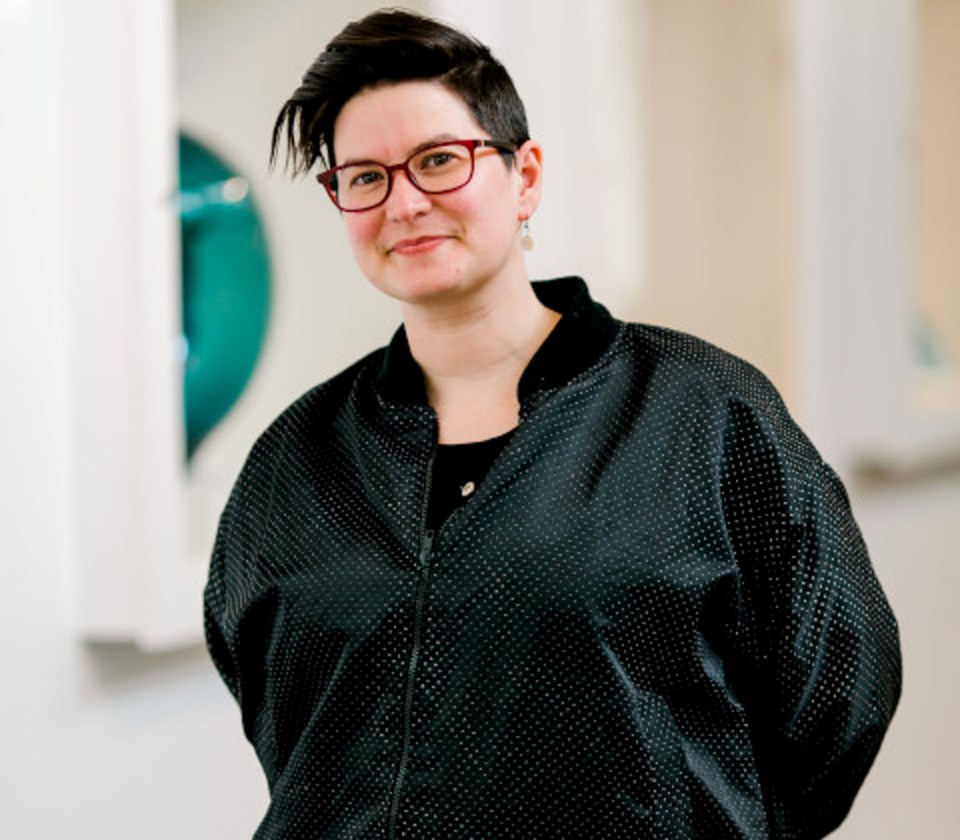For some people, a porcupine quill might be something to back away from, but for Indigenous artist Vanessa Dion Fletcher, they are integral pieces to her creative – and learning – process.
A Lenape and Potawatomi neurodiverse artist, Dion Fletcher’s remarkable art is at the heart of Backwards & Forwards: Reflections in Porcupine Quills, an exhibition now on at the Aurora Cultural Centre.
Curated by Aram Han Sifuentes, Backwards & Forwards is at the centre’s temporary gallery space at Town Hall through Sept. 17.
“These works range from intimate pieces on paper to large mural installations,” says the Aurora Cultural Centre. “At the core is a negotiation between the artist’s hands and porcupine quills. She pulls them from the body of a porcupine, stains them using natural and synthetic dyes, handpicks each quill based on its colour, shape, and size, and bends them onto paper with thread. The building up of the quills form abstract shapes and lines that are elemental and can be interpreted in multiple ways, where a circle in quillwork can represent time, a colour wheel, and a portal all at once.
“Slowness is an important political aspect of Dion Fletcher’s practice. The making is inherently slow, and the intended experience for the viewers is also slow, where one slowly follows the lines and details of the quillwork and gradations of colour. Slowness is also a reflection on neurodiversity, where ‘being slow’ is a derogatory term used for those who are neurodiverse. In emphasizing slowness through porcupine quills, Vanessa Dion Fletcher claims indigeneity in process and craft but also approaches and understandings of neurodiversity and disability.”
Bringing the show together was not a fast process for Han Sifuentes.
A Korean-American, Han Sifuentes says when Dion Fletcher asked her to curate her unique exhibition, it was a “learning curve” to gain knowledge on quillwork, but was very excited to take on the task.
“Why Vanessa asked me to be the curator is one of the conversations that I had been having within the fields of craft, being able to embrace diversity within the fields of craft and really looking at this hemisphere in northern America being able to really embrace and really do our work to honour Indigenous craft, artists and artisans,” said Han Sifuentes. “I wanted to talk about the stories and talk about the metaphor that she uses in her practice. Her work just seems really simple when you look like it in terms of the quill work but what she’s doing in the context and conversation round craft, around neurodiversity is also very strong and very powerful, so I wanted to be able to talk about all the things she is doing in her practice.
“Being neurodiverse as well and really thinking about deconstructing the western approach to neurodiversity and really thinking about learning itself and embracing that there are many different ways to learn – that is something she really wanted to do in this work as well. She was telling me about the quill work that she was making and how a lot of it reminded her about how she was learning [the Lenape language]. For her, how she was learning it was she would have to learn the syllables forwards, then backwards, then forward again. Thinking about a lot of these spirals and circles and wheels that she’s making, I was asking her, how does one read it? I think a lot of us would read it from going around the circle clockwise but she was actually talking about the circles being really important because you can learn it backwards and forwards. That is how she was thinking how people read and approach her quillwork. You can go kind of in multiple directions. She was thinking along these lines in quillwork as storytelling and reading and how you can go in multiple directions.”
Quills as an art medium might be deceptively simple, but how they are transformed is unique, and the results intricate and spectacular.
The artist harvests the quills herself, including from porcupines that didn’t quite make it across the road, makes natural dyes from plants and other materials wherever possible, and the process to get from quill to finished artwork is both methodical and powerful.
For more information on Backwards & Forwards: Reflections in Porcupine Quills, including video Art Bytes with the artist, visit auroraculturalcentre.ca/backwards-and-forwards.
Brock Weir is a federally funded Local Journalism Initiative reporter at The Auroran



